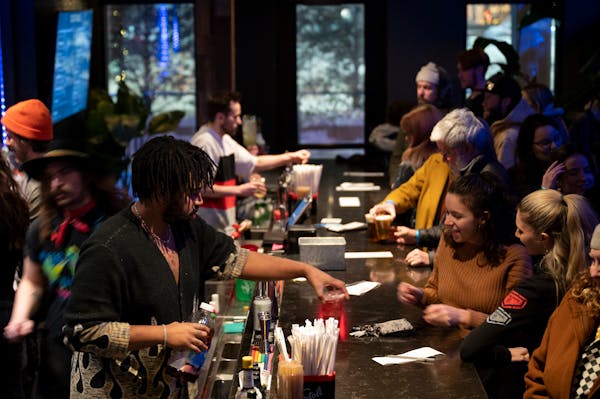You could call it a $100 million flight: I'm cruising a few thousand feet above Lake Superior near Duluth, sitting in the backseat of a Navy F/A-18F Super Hornet fighter jet.
The cargo ships on the great lake below look like bathtub toys. It's a beautiful, almost serene experience ... until I hear in my helmet the voice of Lt. Cmdr. Thomas "Franz" Zimmermann, a pilot with the Navy's Blue Angels flight demonstration squadron.
"Ready?" he asks. "Hit it!"
That's my cue to tense the muscles in my core, legs and butt and start a special breathing technique to fight the oncoming high Gs as Zimmermann starts to throw the plane around: A quick inhale. Hold for a count of three. Explosive exhale making a "HKKK!" sound. Repeat.
I don't know what the plane is doing, but the earth is whirling around violently. Zimmerman says we're reaching 7Gs. My body feels like it's being crushed by a giant weight. I make sure to keep my head upright, otherwise the force would bend me over until my head was in my lap. Despite my best efforts, my vision starts to dim. Everything starts turning black.
But first, a few words on how I got into this situation.
The Blue Angels are in Minnesota headlining the Duluth Air and Aviation Expo this weekend. I submitted an application to take a pre-show media ride in one of the team's jets.
But the Navy first required that I get a physical and a physician's signature saying that I was fit enough to ride in a high performance aircraft.
"Flight in a Blue Angels F/A-18 is extremely physically demanding and not suitable for everyone," the Navy paperwork said.
My doctor signed off, but she suggested that it would be best if I brought my personal physician along. Would there be a seat on the jet for her? (A little medical humor, there.)
On the day of the flight, I was told to avoid physical activity, greasy or acidic food and to be sure I was hydrated. I got a pre-flight briefing along with Nathan Glöckle, a high school principal with the Duluth Public Schools Area Learning Center. He was chosen to take a demo flight as part of a program to celebrate a local who has made a contribution to the community.
Blue Angels crew chief Dale Pascua, a St. Paul native, gave us instructions on the "anti-gravity stress maneuver," the breathing and muscle flexing that helps keep blood flowing to your brain. Imagine you're squeezing a medicine ball between your legs, he said.
Pascua also told us about the only switch that we would be asked to touch in the cockpit. That was the black and yellow one that would arm the ejection seat in case of an emergency. Pascua told us what would happen during an ejection, how to steer the parachute away from water and towers, how to position our bodies when we hit the ground.
He said if we got ejected, we should consider that a "bonus ride." (A little Navy humor.)
Glöckle took the first ride. He and Zimmermann zoomed down the runway and then blasted straight up, twisting as they climbed. About 45 minutes later, Glöckle climbed a bit unsteadily out of the plane.
"I want to kiss the ground, I think," he said. He spent a few minutes sitting down on a step, holding his head in his hands. I watched him, a little nervously.
"Buckle up," he told me. "It's a trip."
When it was my turn, I lost count of the straps that Pascua tightened around my legs, my torso and my shoulders. He tucked a couple of all-important plastic barf bags under one of the leg straps, just in case.
Then we blasted off. We did barrel rolls. We did loops. We did tight turns. We flew upside down. I experienced negative Gs, positive Gs and zero gravity. We flew as slow as 100 miles per hour and almost as fast as the speed of sound. We did a high G maneuver used for landing on an aircraft carrier that you'll never experience on a passenger jet. It was far beyond any amusement park thrill ride or roller coaster experience.
Happily, I didn't throw up. And after a few minutes on the ground sipping water, I felt good enough to eat some of the Tobies donuts I brought from Hinckley to give to the Blue Angels. I ate just half a donut and left the other half in the box. (A little Minnesota humor.)
My flight gave me an appreciation for these amazing and powerful machines, and an even greater appreciation for the people who fly them. I struggled not to black out just riding as a passenger. They experience the same stresses while flying the plane through precision maneuvers.
If you go to the show this weekend, you have a chance to see Lt. Amanda Lee, Blue Angels pilot #3. The Mounds View native enlisted in the Navy while attending the University of Minnesota Duluth. Last year, she became the first female demonstration pilot in the 76-year-history of the Blue Angels.
Tickets and the schedule for the Duluth Airshow can be found at duluthairshow.com.

The 5 best things our food writers ate this week

A Minnesota field guide to snow shovels: Which one's best?

Summer Camp Guide: Find your best ones here

Lowertown St. Paul losing another restaurant as Dark Horse announces closing







